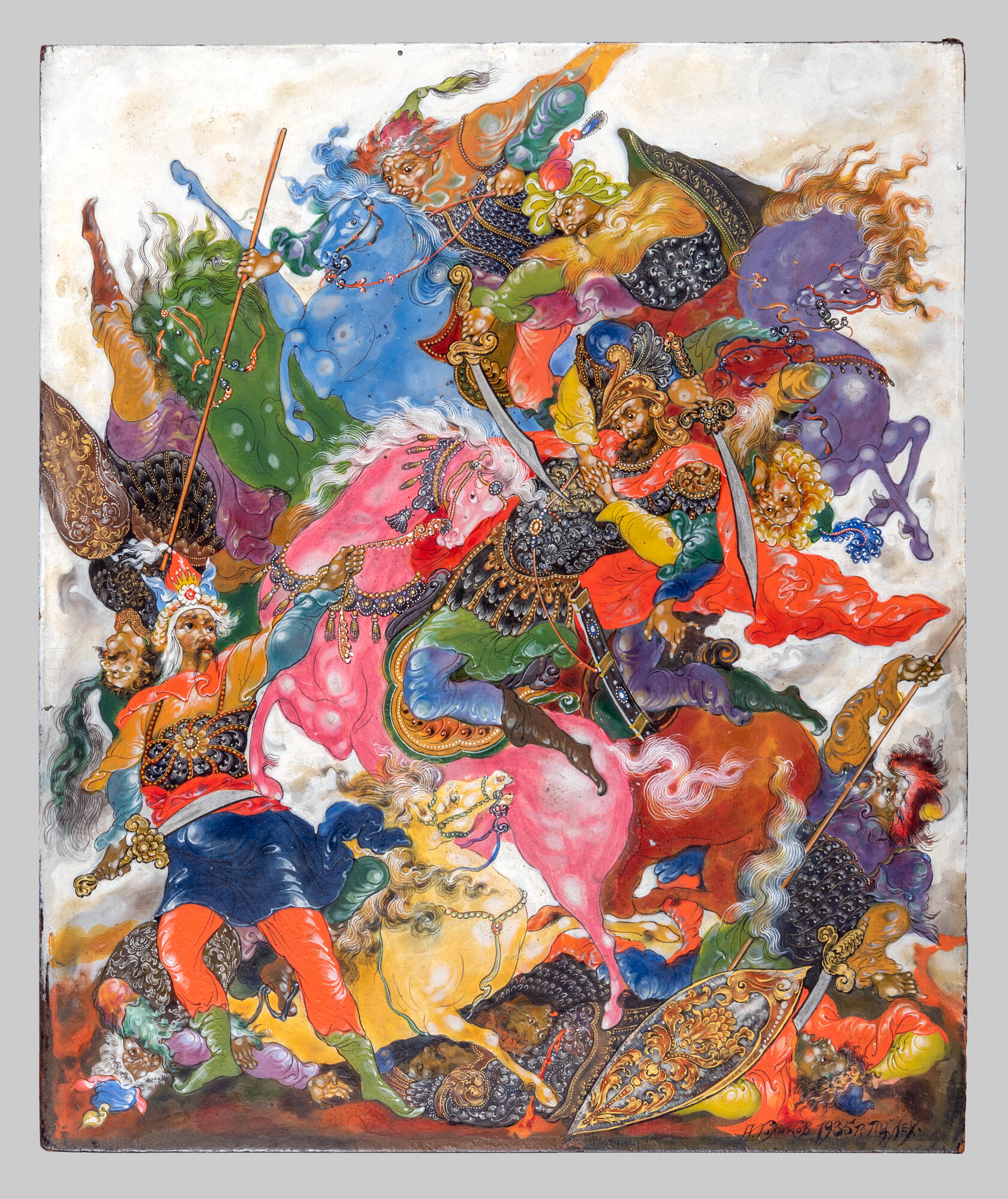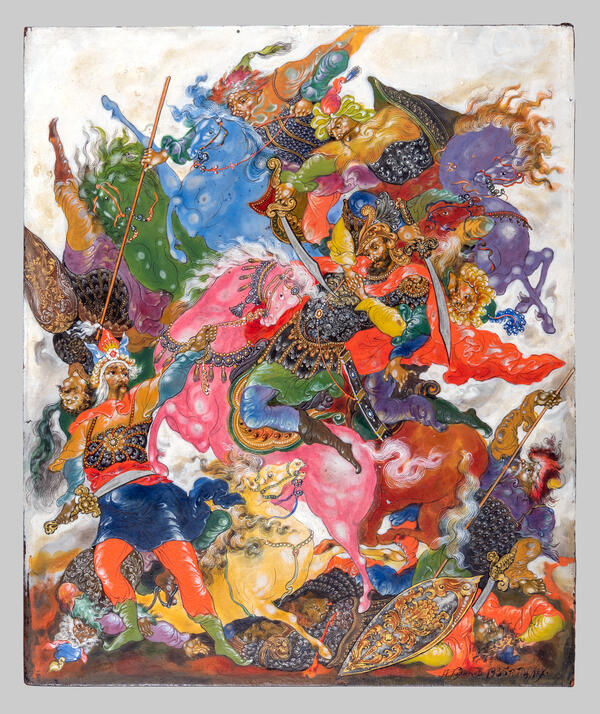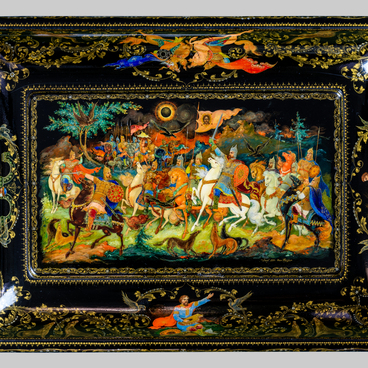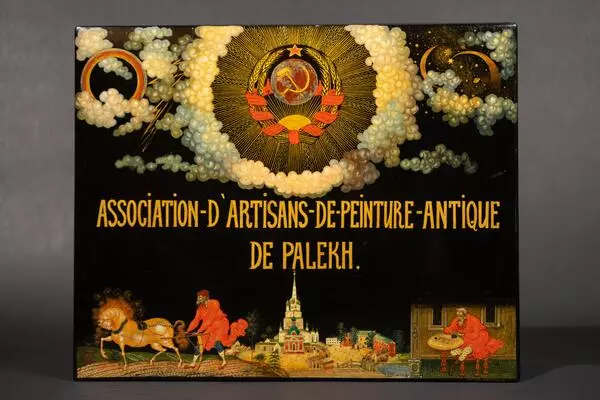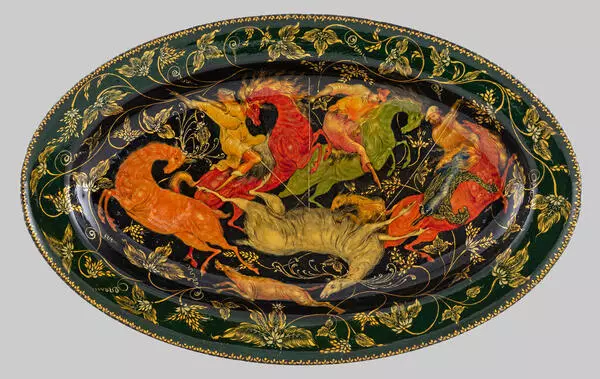Ivan Golikov created the ‘The Capture of Igor’ plate in 1935. It was one of the illustrations he proposed for the anniversary edition of ‘The Tale of Igor’s Campaign’ which was scheduled for publication in 1930's.
In the early 1932, Maxim Gorky has advised the Academia publishing house to give Ivan Golikov the illustration contract for this edition. He wrote to the poet Dmitry Semenovsky: “If Academia will do business with Golikov alone, they will already ensure the artistic consistency of style across the book”s embellishments.”
Gorky’s recommendation was accepted, and the artist produced over 100 designs in record time (around 2 years). The artist created colorful illustrations, headpieces, endings, initial letters and designed the title-cover. In addition, he wrote the text of the Tale in the style of the Old Russian statutory writing. Golikov’s work was praised by critics: they said that his “miniatures are a celebration of symbolic colors”, and that “Ivan Golikov brought to life what was hidden in the verbal ligature of the work.” The 1934 edition of the Tale is considered a classic of Palekh book illustration.
The artist created “The Capture of Igor” plate shortly after the book was published — in the span of a year after the event. He was still drawing inspiration from the theme of ancient battles. He depicted the battle scene: Prince Igor Svyatoslavich fighting with the Polovtsy. The layers of color are dense and heavy here, and the colors themselves are bold and intense.
Each character the artist painted here is unique: the warriors have individual facial features, they make different gestures, and their figures are all viewed from different angles. Sometimes the excessive deformation of their bodies is credited to the artist’s lacking skills; some say he is simply ignorant and doesn’t know anything about the proportions and scaling in the human figure. This interpretation, however, is missing the forest for the trees: the artist is highlighting the unfathomable tension of the battle, portraying broken and mangled bodies.
Ivan Golikov went through 18 battles of the First World War. He saw death, and he saw disfigured bodies. And yet, there is no leitmotif of destruction to be found in his artworks. The battles he paints are full of their own unique symbolism. Mortal battles between enemies become the conflict of the opposites. In Ivan Golikov’s paintings, there are confrontations, but nobody is ever triumphant or defeated. They aim to remind us that the struggle between the old and the new is eternal like the creation itself.
‘The Capture of Igor’ is an artwork from the later period of his life. The researchers note that Ivan Golikov tended to paint battle scenes differently in his early illustrations. Most of his first compositions were pyramid-shaped with action that moved upwards. In these works, the central part was easy to discern, whereas in his later works it became quite difficult to find the singular semantic centre.
In his early artworks the heroes were depicted in a semblance of real world and in a semblance of a real landscape, even though it was created with the conventional language of the Palekh miniature. As time went on, Ivan Golikov started to move away from the landscapes, eventually abandoning them completely. In ‘The Capture of Igor’ he depicted the battle on a white background — as if the battle was happening on some unearthly plane.
In the early 1932, Maxim Gorky has advised the Academia publishing house to give Ivan Golikov the illustration contract for this edition. He wrote to the poet Dmitry Semenovsky: “If Academia will do business with Golikov alone, they will already ensure the artistic consistency of style across the book”s embellishments.”
Gorky’s recommendation was accepted, and the artist produced over 100 designs in record time (around 2 years). The artist created colorful illustrations, headpieces, endings, initial letters and designed the title-cover. In addition, he wrote the text of the Tale in the style of the Old Russian statutory writing. Golikov’s work was praised by critics: they said that his “miniatures are a celebration of symbolic colors”, and that “Ivan Golikov brought to life what was hidden in the verbal ligature of the work.” The 1934 edition of the Tale is considered a classic of Palekh book illustration.
The artist created “The Capture of Igor” plate shortly after the book was published — in the span of a year after the event. He was still drawing inspiration from the theme of ancient battles. He depicted the battle scene: Prince Igor Svyatoslavich fighting with the Polovtsy. The layers of color are dense and heavy here, and the colors themselves are bold and intense.
Each character the artist painted here is unique: the warriors have individual facial features, they make different gestures, and their figures are all viewed from different angles. Sometimes the excessive deformation of their bodies is credited to the artist’s lacking skills; some say he is simply ignorant and doesn’t know anything about the proportions and scaling in the human figure. This interpretation, however, is missing the forest for the trees: the artist is highlighting the unfathomable tension of the battle, portraying broken and mangled bodies.
Ivan Golikov went through 18 battles of the First World War. He saw death, and he saw disfigured bodies. And yet, there is no leitmotif of destruction to be found in his artworks. The battles he paints are full of their own unique symbolism. Mortal battles between enemies become the conflict of the opposites. In Ivan Golikov’s paintings, there are confrontations, but nobody is ever triumphant or defeated. They aim to remind us that the struggle between the old and the new is eternal like the creation itself.
‘The Capture of Igor’ is an artwork from the later period of his life. The researchers note that Ivan Golikov tended to paint battle scenes differently in his early illustrations. Most of his first compositions were pyramid-shaped with action that moved upwards. In these works, the central part was easy to discern, whereas in his later works it became quite difficult to find the singular semantic centre.
In his early artworks the heroes were depicted in a semblance of real world and in a semblance of a real landscape, even though it was created with the conventional language of the Palekh miniature. As time went on, Ivan Golikov started to move away from the landscapes, eventually abandoning them completely. In ‘The Capture of Igor’ he depicted the battle on a white background — as if the battle was happening on some unearthly plane.
